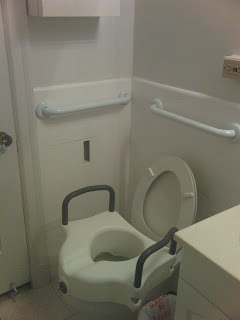1 Hour Hands-on Disabled Person Transfer Course Should be Mandatory in Architectural Education
My blog momentum was in full swing three months ago and then was suddenly interrupted by family illness. Hence the 3 month gap in weekly blog posts. Now that said family member is recovering miraculously well and his rehabilitation efforts are showing tremendous progress and success all around I have time, albeit limited, to get back into my blog momentum.
I don’t think that anyone is ever prepared for catastrophic illness; neither the individual nor the family. My family was suddenly confronted with catastrophic illness this past June 2010. As a side point, I was born again last summer in 2009 and so I had no doubts that we would have victory over this illness. It’s been a tremendous test of Christian faith, incessant prayer and a test of mental and physical strength for all of us. All of the sudden my healthy 28 year old, 6’-5 ½”, 220 lb brother needed brain surgery to remove a nasty 2 inch tumor in the middle of his head. He was temporarily paralyzed on his left side from the surgery. He currently walks with a cane and has a wheel chair. He needs assistance to turn on his side when he sleeps at night. He needs assistance getting in and out of bed, walking, bathing…and we’re right here 24/7 to help him.
Even though I’ve spent almost 6 years in healthcare design and have drawn and redlined ADA bathrooms and other accessible spaces for years, none of that matters in comparison to firsthand experience of transferring a disabled person from let’s say the wheel chair to the bed. Or from standing with a cane to sitting on the commode. Or getting in and out of the car passenger seat. No accessibility guidelines book or seminar or online lecture can truly impress how to design accessible spaces which are functional, beautiful and complimentary to the overall building design. Just memorizing the dimension and fixture requirements helps for legal reasons but is silly really and does not guarantee good design. The most practical method for truly learning and understanding the ADA requirements is obviously the hands-on experience. Such experience not only enables architects to fully understand and implement the requirements but also to use their architectural talents and actually design artistic accessible spaces. At minimum, all architects should be required to transfer a disabled person onto a toilet from a wheel chair and then help them wash their hands and exit the bathroom. This is especially needed if they are going to work in healthcare design.
Our CCS Architecture and Interior Design philosophy is that architecture is an art and that all buildings and interiors should be works of art, regardless of program, code etc. A good architect has the talent to include universal and accessible spaces in their design without sacrificing the art of architecture. The only way for an architect to truly incorporate wide aisles and 5 ft turning radii gracefully and elegantly in their design is if they physically experience what it’s like to push a wheel chair from room to room and transfer a disabled person from space to space. Only then will they intimately know how to make the space beautiful and proportioned. Just copying the minimum corridor dimension from an ADA book doesn’t cut it. A 1 hour hands-on disabled person transfer course should be mandatory in architectural education.
Best wishes,
CCS Architect
Visit our website www.ccsarchenter.com for more information about CCS Architecture and Interior Design and visit our blog to read this post at http://ccsarchenter.blogspot.com Also follow CCS on twitter http://twitter.com/CCSArchitect


Comments
Post a Comment